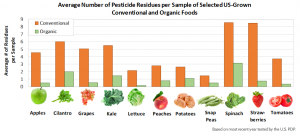“The dietary risk index system: a tool to track pesticide dietary risks”
Co-authors: Charles Benbrook and Don Davis
Published: October 14, 2020 in Environmental Health.
Full Citation: Benbrook, Charles M., & Davis, Donald R.; “The dietary risk index system: a tool to track pesticide dietary risks;” Environmental Health, 2020, 19(1); DOI: 10.1186/s12940-020-00657-z.
Access the full-text here.
Introduction

This peer-reviewed paper describes the methodologies and data sources incorporated in the Dietary Risk Index system, or DRI. This system quantifies the relative risks from exposure to pesticides in foods. The paper serves as a gateway to an analytical system that, for the first time, provides insights into the levels and distributions of pesticide risks in different foods, in foods grown in the U.S. versus imported food, and in conventionally grown versus organic food.
In short, applications of the DRI show clearly where the “hot potatoes” are in the food supply relative to pesticide risk, as well as the significant share of the food supply posing little or no risk. DRI tables drive home the fact that pesticide dietary risk is substantially concentrated in just a few dozen foods, and for these relatively high-risk foods, a small percent of annual production accounts for most of the risk.
These findings support two encouraging conclusions. First, for all crops, many farmers have developed Integrated Pest Management (IPM) systems that routinely avoid significant residues and pesticide risk. By investing in prevention-based research and IPM system innovation, the same success in avoiding high-risk pesticide uses can be replicated on a higher percentage of annual production.
Second, regulators can dramatically reduce overall pesticide dietary risk by focusing on the few pesticide-food combinations accounting for most pesticide risk. They have a number of tools to draw upon in reducing residues including lowering maximum, allowed application rates, extending pre-harvest intervals, and altering how pesticides are applied (i.e. switching from liquid sprays onto growing plants to granular applications incorporated into the soil).
DRI System Capabilities
The DRI system estimates pesticide dietary risks across foods and pesticides over time based on pesticide residue data from the U.S. Department of Agriculture and pesticide toxicology metrics from regulatory agencies in the U.S. and U.K. (More on DRI data sources is here). By incorporating residue data on imports and exports from both countries, the DRI system “is capable of assessing pesticide risks in a significant portion of the global food supply” (Benbrook and Davis, 2020).
DRI values are calculated using available residue data, the recommended serving sizes of a given food, and a person’s body weight. Since it has already been established that children are especially vulnerable to pesticide exposure, the weight of an average 4-year old child — 35 pounds (or 16 kilograms) — is used to calculate DRI values for this paper.

As the author’s note in the paper abstract, “the DRI system provides insights into the levels, trends, and distribution of pesticide dietary risk across most widely consumed foods” (Benbrook and Davis, 2020). The system can be used to generate tens of thousands of tables by food, pesticide, country of origin, farming system and year. It allows for comparisons of domestics vs. imports, and organic and conventional foods.
It is the author’s hope that “the DRI system can both highlight where to focus efforts in mitigating pesticide dietary risks, and track progress toward that goal” (Benbrook and Davis, 2020).
There’s much more on the DRI here on Hygeia. Access several DRI interactive tables on your own via our Interactive Lookup Tools.
Benbrook and Davis, 2020: Key Findings
I: The good news: Dietary risk from pesticide exposure in the food supply is generally low.

The DRI system shows that “relatively few foods — mostly fresh fruits and vegetables— account for the lion’s share of pesticide dietary risks, while grains and animal products account for generally modest risks” (Benbrook and Davis, 2020). It also clearly indicates progress in reducing certain risks as a result of passage of the 1996 Food Quality Protection Act (FQPA – see the Risk Assessment and Regulation section for much more on this key legislation).
One example cited in the paper is the toxic organophosphate methyl-parathion. This pesticide was found in over 41% of the peach samples tested by the USDA in 1996, at levels well above EPA’s “level of concern.” The EPA prioritized ending its use on soft skinned fruits and vegetables as the FQPA was implemented in 1998-2000. The authors point out that “this goal [ending methyl parathion presence in peaches] was largely accomplished by the end of 2001; the last peach sample found by the US-PDP to contain a methyl-parathion residue was from a domestic sample in 2008” (Benbrook and Davis, 2020).
II: The stubborn and bad news: High-risk samples continue to be found among the samples tested of several conventionally grown foods, including both U.S. grown and imported foods.
The DRI system quantifies pesticide risk in many different ways. For several examples, see our Interactive Lookup Tools.
Important insights into the distribution of pesticide risks in the annual supply of a given food can be gained from analyses of individual food sample residues and DRI-risk data. For most foods, a few high-residue samples account for the bulk of the dietary risk stemming from all samples tested. Identifying these high-risk food/pesticide combinations and samples can help pinpoint opportunities to reduce risk.
For example, the Hot Potatoes page presents an analysis of the 1,107 samples of domestically-grown kale tested by the USDA’s Pesticide Data Program in 2018. In this case, the top-five riskiest samples had average DRI values almost 63,700-times higher than the cleanest 10% of the samples! Breaking these samples down into 10 equal groups, or deciles, demonstrates how skewed pesticides risks are across the annual supply of one important leafy green crop (kale):

The 10% of the samples with the highest DRI account for the vast majority of the risk. The DRI system provides an important opportunity to identify and address these high-residue, high-risk food/pesticide combinations.
III: Organic foods have much lower DRI values than conventionally grown foods, and deliver on their promise to markedly reduce pesticide dietary exposure and risk.
The DRI system generates reports that compare and contrast residue levels in organic vs conventionally produced foods. While organic certification precludes the use of most chemical pesticides on organic crops, residues are sometimes detected on organic foods.
Some residues are present from use of biopesticides that have been approved for use on certified organic food. But most of the residues found in organic food should not be there. Such residues find their way onto organic food in many ways. Some occur on the farm, while other pathways arise as harvested crops are processed, stored, and transported.
In a few foods, residues are still detected from persistent, legacy insecticides such as DDT that remain in soil for decades.
Post-harvest fungicides used in conventional fruit and vegetable packing plants also often wind up on the organic produce also processed in such plants. Other pesticides can drift onto organic fields from neighboring conventional crops.
But, as the graphic below shows, overall dietary risk from organic foods are significantly lower than their conventional counterparts. Thus, selecting organic brands of soft-skinned fruits and veggies that tend to have high-risk pesticide residues is a proven, practical strategy to reduce risk. (See our special coverage on Organic Integrity for much more on residues in organic foods).

